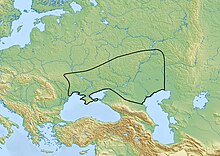
Back Srubna mədəniyyəti Azerbaijani Бура мәҙәниәте Bashkir Срубна култура Bulgarian Cultura Srubna Catalan Srubna-Kultur German Cultura srubna Spanish فرهنگ گورالواری Persian Culture Sroubna French Cultura di Srubna Italian Cultur Srubna LFN
You can help expand this article with text translated from the corresponding article in Russian. (November 2018) Click [show] for important translation instructions.
|
 | |
| Geographical range | Pontic steppe |
|---|---|
| Period | Bronze Age |
| Dates | ca. 1900 BC – 1200 BC |
| Preceded by | Abashevo culture, Multi-cordoned ware culture, Sintashta culture, Lola culture |
| Followed by | Noua-Sabatinovka culture, Trzciniec culture, Belozerka culture, Bondarikha culture, Scythians, Sauromatians |
The Srubnaya culture (Russian: Срубная культура, romanized: Srubnaya kul'tura, Ukrainian: Зрубна культура, romanized: Zrubna kul'tura), also known as Timber-grave culture, was a Late Bronze Age 1900–1200 BC culture[1][2][3] in the eastern part of the Pontic–Caspian steppe. It is a successor of the Yamna culture, the Catacomb culture and the Poltavka culture. It is co-ordinate and probably closely related to the Andronovo culture, its eastern neighbor.[3] Whether the Srubnaya culture originated in the east, west, or was a local development, is disputed among archaeologists.[3]
The Srubnaya culture is generally associated with archaic Iranian-speakers.[3][4] The name comes from Russian сруб (srub), "timber framework", from the way graves were constructed.
- ^ Brown, Dorcas, and David Anthony, (2017). "Bronze Age Economy and Rituals at Krasnosamarskoe in the Russian Steppes", in: The Digital Archaeological Record: "...Particular attention focuses on the role of agriculture during the unusual episode of sedentary, settled pastoralism that spread across the Eurasian steppes with the Srubnaya and Andronovo cultures (1900-1200 BC)..."
- ^ Parpola, Asko, (2012). "Formation of the Indo-European and Uralic (Finno-Ugric) language families in the light of archaeology: Revised and integrated ‘total’ correlations", in Mémoires de la Société Finno-Ougrienne, Helsinki, p. 140.
- ^ a b c d Mallory & Adams 1997, pp. 541–542.
- ^ Kuzmina 2007, p. 452.